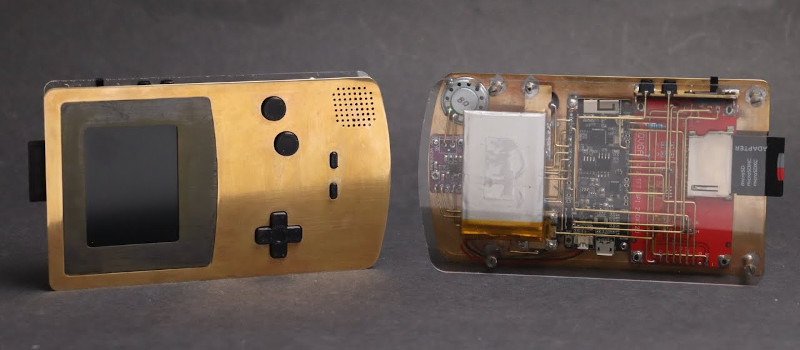Nintendo’s Game Boy is legendary for being the meat in the handheld gaming revolution, as well as being nigh-on indestructible whether in the custody of children or soldiers in the Gulf War. However, [Jiri] decided to see if he could whip up a tribute of his own, in brass instead of plastic.
The hardware is based on the Odroid GO emulator firmware for the ESP32, running on a 2.2″ color TFT screen. It’s a great base for a custom build, which avoids gutting any precious classic hardware. It’s then assembled behind front plate milled out of brass, with delicate point-to-point brass wires giving it an artistic circuit sculpture look. The brass did prove difficult to work with at times, acting as a heat sink which prevented easy soldering of the standoffs in place. To get around this, [Jiri] used a hotplate to heat the plate from below, keeping it warm enough so that a hand iron could do the job.
The final result is a fun Game Boy emulator in a stylish case – though one you shouldn’t throw in a back pack lest it short out the exposed conductors. It would make a great gift for any lifelong Nintendo fan. [Jiri] is no strange to circuit sculpture, as we well know – we’ve featured his tools and methods before. Video after the break.
















Keep in mind that brass is toxic, if you want to touch it – wear gloves.
Citation needed.
It’s an alloy containing lead. I often wondered why brass is considered safe but lead is not.
Brass is a copper and zinc alloy by definition. Lead and other elements are added only if certain properties are needed. Because of copper, brass has natural antimicrobial properties, but is not considered toxic to humans unless you do something like breathe the metallic dust during manufacturing.
Some brasses contain lead, most do not.
Brass is (in general) safe for skin contact, just don’t eat it….
On topic: This thing is beautifully done.
Most commonly used brass alloys contain a material amount of lead. It makes it easier to machine and there will be less wear on the tooling so it lowers production costs. It’s sort of like machining steel instead of machining stainless steel. You can certainly source lead free brass but even then it is difficult to completely avoid. Even the revised USA “lead free” limits for NSF or food grade applications are actually not fully lead free. Just lower than the 6% or so they were before and those only fairly recently phased in so don’t expect to see them in any home built in the last 40+ years.
I would advise against something with 6% or even 2.5% lead being commonly used for skin contact as lead exposure is additive over time. Obviously breathing in particles would be more problematic but lead is not something that you typically want exposure to. I would personally wear gloves when handling and a suitably rated mask when machining brass and generally avoid food stored in brass or PVC for that matter and generally try to avoid exposure to it in food grade applications. It’s certainly a balancing act and often times difficult to avoid given most cheap household products you would not even think about such as laundry hoses contain brass and often flexible PVC as well but the rather abundant amount of data available is fairly clear that lead exposure isn’t a good thing so taking steps to at least be aware of the types of exposure and what reasonable steps could be taken to avoid it are probably good long term ideas to be aware of and at least try to consider.
Unless you are a bacteria that is bovine manure..
Oh man, someone better get on the horn (heh) with brass instrument players everywhere…
I suspect that your tin foil hat might be the root cause of the problem here..
Well, if you are melting it do so outside and don’t breathe the yellow zinc smoke.
It’s good stuff to touch though, a natural disinfectant thanks to the copper.
Bullshit
that brass wiring WOW its a sculpture! Amazing work
Such brazen mimicry
I’m sure you meant “brassen” (as a pun)?
I’m sure they meant it as the pun it already is…
braze
/breɪz/
verb
form, fix, or join by soldering with an alloy of copper and zinc at high temperature.
“the company adapted its process to braze the flute components under vacuum”
noun
a brazed joint.
The only thing that would make it better is intricate engraving (can you laser engrave on brass?) on the brass, but I still give it 9.9 out of 10.
My ant loves to play with it.
Hackaday